Antimony’s Significance as a Critical Metal: The Global Perspective and the Greek Deposits
Abstract
1. Introduction
2. Global Perspective
2.1. World Resources, Production and Perspectives
2.2. Antimony Uses, Substitution, Recycling and Environmental Considerations
2.3. Characteristics and Classifications of Antimony Deposits
3. Greek Antimony Deposits and Perspectives
3.1. Central—Eastern Macedonia and Thrace: Geology, Tectonic Setting, and Antimony Deposits
3.1.1. Kallintiri
3.1.2. Lachanas
3.1.3. Gerakario
3.1.4. Philadelphia
3.2. Chios Island Geology, Tectonic Setting, and Antimony Deposits
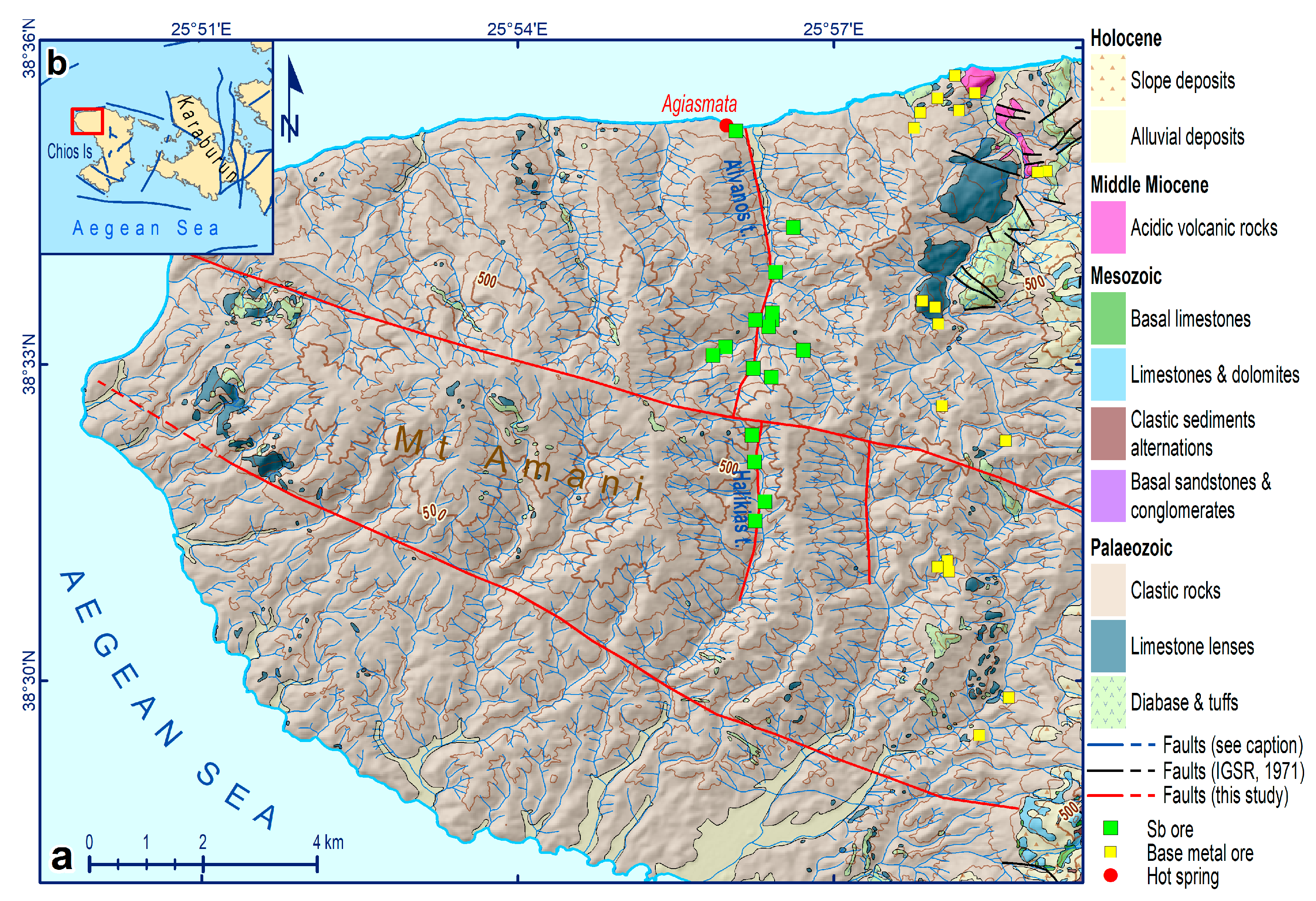
3.3. Samos Island Geology, Tectonic Setting, and Antimony Deposits
3.4. Pelion (SE Thessaly) Geology, Tectonic Setting, and Antimony Deposits
3.5. Minor Occurrences of Antimony in Other Type of Deposits
4. Discussion and Conclusions
Author Contributions
Funding
Data Availability Statement
Conflicts of Interest
References
- European Commission, Directorate-General for Internal Market. Industry, Entrepreneurship and SMEs. In Study on the Critical Raw Materials for the EU 2023—Final Report; Grohol, M., Veeh, C., Eds.; Publications Office of the European Union: Luxembourg, 2023; Available online: https://data.europa.eu/doi/10.2873/725585 (accessed on 1 September 2023).
- U.S. Congress. Consolidated Appropriations Act. 2021. Available online: https://rules.house.gov/sites/democrats.rules.house.gov/files/BILLS-116HR133SARCP-116-68.pdf (accessed on 4 March 2021).
- Seal, R.R., II; Schulz, K.J.; DeYoung, J.H., Jr.; Sutphin, D.M.; Drew, L.J.; Carlin, J.F., Jr.; Berger, B.R. Antimony. In Critical Mineral Resources of the United States—Economic and Environmental Geology and Prospects for Future Supply; Schulz, K.J., DeYoung, J.H., Jr., Seal, R.R., II, Bradley, D.C., Eds.; Geological Survey Professional Paper 1802; U.S. Geological Survey: Reston, VA, USA, 2017; 19p, C1–C17. [Google Scholar] [CrossRef]
- Lusty, P.A.J.; Shaw, R.A.; Gunn, A.G.; Idoine, N.E. UK Criticality Assessment of Technology Critical Minerals and Metals; British Geological Survey Commissioned Report, CR/21/120; British Geological Survey: Nottingham, UK, 2021; 76p. [Google Scholar]
- Government of Canada. The Canadian Critical Minerals Strategy. From Exploration to Recycling: Powering the Green and Digital Economy for Canada and the World. Government of Canada. 2022. Available online: https://www.canada.ca/en/campaign/critical-minerals-in-canada/canadian-critical-minerals-strategy.html (accessed on 15 September 2023).
- European Commission. Critical Raw Materials for the EU. European Commission. 2010. Available online: https://ec.europa.eu/growth/sectors/raw-materials/specific-interest/critical_en (accessed on 1 May 2023).
- Miller, M.H. Antimony. In United States Mineral Resources; Brobst, D.A., Pratt, W.P., Eds.; U.S. Geological Survey Professional Paper 820; US Government Printing Office: Washington, DC, USA, 1973; pp. 45–50. [Google Scholar]
- Rudnick, R.L.; Gao, S. Composition of the Continental Crust, Treatise on Geochemistry, 2nd ed.; Elsevier Ltd.: Amsterdam, The Netherlands, 2014. [Google Scholar] [CrossRef]
- Eyi, E. Antimony Uses, Production, Prices; Tristar Resources plc: London, UK, 2012; p. 14. [Google Scholar]
- Boyle, R.W.; Jonasson, I.R. The geochemistry of antimony and its use as an indicator element in geochemical prospecting. J. Geochem. Explor. 1984, 20, 223–302. [Google Scholar] [CrossRef]
- Van den Brink, S.; Kleijn, R.; Sprecher, B.; Mancheri, N.; Tukker, A. Resilience in the antimony supply chain. Resour. Conserv. Recycl. 2022, 186, 106586. [Google Scholar] [CrossRef]
- Mordor Intelligence. Market Snapshot. Mordor Intelligence. 2021. Available online: https://www.mordorintelligence.com/industry-reports/antimony-market (accessed on 15 September 2023).
- Perpetua Resources. Antimony. A Critical Metalloid for Manufacturing, National Defense and the Next Generation of Energy Generation and Storage Technologies. Perpetua Resources. 2021. Available online: https://perpetuaresources.com/wp-content/uploads/Antimony-White-Paper.pdf (accessed on 1 February 2023).
- Roskill. Extract of Antimony: Global Industry, Markets and Outlook to 2028, 13th ed; Roskill Information Services Ltd.: London, UK, 2018; 194p. [Google Scholar]
- U.S. Geological Survey (USGS). USGS Mineral Commodities Summary for 2023: Antimony; USGS: Reston, VA, USA, 2023.
- Carlin, J.F., Jr. Antimony: U.S. Geological Survey Mineral Commodity Summaries 2011; USGS: Reston, VA, USA, 2011; pp. 18–19. Available online: https://minerals.usgs.gov/minerals/pubs/commodity/antimony/mcs-2011-antim.pdf (accessed on 1 September 2022).
- U.S. Geological Survey (USGS). Mineral Commodity Summaries; USGS: Reston, VA, USA, 2022. [CrossRef]
- European Commission; Directorate-General for Internal Market, Industry, Entrepreneurship and SMEs; Blengini, G.; Cynthia, E.L.; Eynard, U.; De Matos Cristina, T.; Dominic, W.; Konstantinos, G.; Claudiu, P.; Samuel, C.; et al. Study on the EU’s List of Critical Raw Materials (2020)–Executive Summary; Publications Office: Luxembourg, 2020; Available online: https://data.europa.eu/doi/10.2873/24089 (accessed on 1 February 2023).
- Laznicka, P. Quantitative relationships among giant deposits of metals. Econ. Geol. 1999, 94, 455–473. [Google Scholar] [CrossRef]
- Laznicka, P. Giant Metallic Deposits—Future Sources of Industrial Metals; Springer: Berlin, Germany, 2010; p. 834. [Google Scholar]
- Guberman, D.E. Antimony: U.S. Geological Survey Mineral Commodity Summaries 2014; USGS: Reston, VA, USA, 2014; pp. 18–19. Available online: https://minerals.usgs.gov/minerals/pubs/commodity/antimony/mcs-2014-antim.pdf (accessed on 1 February 2023).
- Schwarz-Schampera, U. Antimony. In Critical Metals Handbook; Gunn, G., Ed.; Wiley and Sons: Hoboken, NJ, USA, 2014; pp. 70–98. [Google Scholar] [CrossRef]
- U.S. Geological Survey (USGS). Mineral Commodities Summary for 2015: Antimony; USGS: Reston, VA, USA, 2016.
- Gibson, R.I. Type-cast—Antimony, the Metallic Sidekick, Sets the World on Fire and Puts it Out. Geotimes 1998, February, 58. Available online: https://www.gravmag.com/antimony.shtml (accessed on 1 September 2023).
- Tercero Espinoza, L.; Hummen, T.; Brunot, A.; Pena Garay, I.; Velte, D.; Smuk, L.; Todorovic, J.; Eijk, C.; Joce, C. CRM_InnoNet. Critical Raw Materials; Substitution Profiles September 2013 Revised May 2015; European Commission: Brussels, Belgium, 2015; 96p. [Google Scholar]
- Roskill. The Economics of Antimony, 10th ed.; Roskill Information Services Ltd.: London, UK, 2007; p. 231. [Google Scholar]
- Wu, F.; Fu, Z.; Liu, B.; Mo, C.; Chen, B.; Corns, W.; Liao, H. Health risk associated with dietary co-exposure to high levels of antimony and arsenic in the world’s largest antimony mine area. Sci. Total Environ. 2011, 409, 3344–3351. [Google Scholar] [CrossRef] [PubMed]
- Rish, M.A. Antimony. In Elements and their Compounds in the Environment—Occurrence, Analysis, and Biological Relevance, 2nd ed.; Merian, E., Anke, M., Ihnat, M., Stoeppler, M., Eds.; Wiley-VCH Verlag: Weinheim, Germany, 2004; Chapter 4; pp. 659–670. [Google Scholar]
- Obolensky, A.A.; Gushchina, L.V.; Borisenko, A.S.; Borovikov, A.A.; Pavlova, G.G. Antimony in hydrothermal processes. Solubility, conditions of transfer, and metal-bearing capacity of solutions. Russ. Geol. Geophys. 2007, 48, 992–1001. [Google Scholar] [CrossRef]
- Pitcairn, I.K.; Teagle, D.A.; Craw, D.; Olivo, G.R.; Kerrich, R.; Brewer, T.S. Sources of metals and fluids in orogenic gold deposits—Insights from the Otago and Alpine schists, New Zealand. Econ. Geol. 2006, 101, 1525–1546. [Google Scholar] [CrossRef]
- Hofstra, A.H.; Marsh, E.E.; Todorov, T.I.; Emsbo, P. Fluid inclusion evidence for a genetic link between simple antimony veins and giant silver veins in the Coeur d’Alene mining district, ID and MT, USA. Geofluids 2013, 13, 475–493. [Google Scholar] [CrossRef]
- Hart, C.J.R. Reduced intrusion-related gold systems. In Mineral deposits of Canada. A Synthesis of Major Deposit Types, District Metallogeny, the Evolution of Geological Priovinces, and Exploration Methods; Goodfellow, W.D., Ed.; Special Publication No.5; Geological Association of Canada, Mineral Deposits Division: St. John’s, NL, Canada, 2007; pp. 95–112. [Google Scholar]
- Pohl, W.L. Economic Geology: Principles and Practice; Wiley Blackwell: Hoboken, NJ, USA, 2011. [Google Scholar]
- Jankovic, S. The complex Antimony-Lead-Zink Deposit at Rujevac/Yugoslavia; its specific geochemical and mineralogical features. Miner. Depos. 1977, 12, 381–392. [Google Scholar] [CrossRef]
- Jankovic, S. Άntimony deposits in Southeastern Europe. Veshik Geol. 1979, 37, 25–48. [Google Scholar]
- Mudrinic, C. The origin of the ore components and the geochemical characteristics of the antimony deposits of Serbia and Macedonia (Yugoslavia). In Proceedings of the Sixth Quadrennial IAGOD Symposium, Tbilisi, Georgia, 6–12 September 1982; E.Schweizerbart’sche: Stuttgart, Germany, 1984. [Google Scholar]
- Dimou, E.; Papastaurou, S.; Serment, R. The antimony in Greece—Part I. In Study of Occurrences and Deposits of Antimony in Northern Greece (Kallintiri, Philadelphia, Lachanas); IGME: Athens, Greece, 1985. (In Greek) [Google Scholar]
- Robertson, A.H.F.; Dixon, J.E. Introduction. Aspects of the geological evolution of the Eastern Mediterranean. Geol. Soc. Spec. Publ. 1984, 17, 1–74. [Google Scholar] [CrossRef]
- Şengör, A.M.C.; Yılmaz, Y.; Sungurlu, O. Tectonics of the Mediterranean Cimmerides. Nature and evolution of the western termination of Palaeo-Tethys. Geol. Soc. Spec. Publ. 1984, 17, 77–112. [Google Scholar] [CrossRef]
- Robertson, A.H.F.; Dixon, J.E.; Brown, S.; Collins, A.; Morris, A.; Pickett, E.; Sharp, I.; Ustaömer, T. Alternative tectonic models for the Late Palaeozoic-Early Tertiary development of Tethys in the Eastern Mediterranean region. Geol. Soc. Spec. Publ. 1996, 105, 239–263. [Google Scholar] [CrossRef]
- Mountrakis, D. Tertiary and Quaternary Tectonics of Greece. In Postcollisional Tectonics and Magmatism in the Mediterranean Region and Asia; Dilek, Y., Pavlides, S., Eds.; Geological Society of America: Boulder, CO, USA, 2006; Volume 409, pp. 125–136. [Google Scholar] [CrossRef]
- Zulauf, G.; Dörr, W.; Fisher-Spurlock, S.C.; Gerdes, A.; Chatzaras, V.; Xypolias, P. Closure of the Paleo-Tethys in the External Hellenides. Constraints from U-Pb ages of magmatic and detrital zircons (Crete). Gondwana Res. 2015, 28, 642–667. [Google Scholar] [CrossRef]
- Zulauf, G.; Dörr, W.; Marko, L.; Krahl, J. The late Eo-Cimmerian evolution of the external Hellenides. Constraints from microfabrics and U-Pb detrital zircon ages of Upper Triassic (meta)sediments (Crete, Greece). Int. J. Earth Sci. 2018, 107, 2859–2894. [Google Scholar] [CrossRef]
- Laskari, S.; Soukis, K.; Stockli, D.F.; Lozios, S.; Zambetakis-Lekkas, A. Reconstructing the southern Pelagonian domain in the Aegean Sea. Insights from U-Pb detrital zircon analysis, lithostratigraphic and structural study, and zircon (U-Th)/He thermochronology on Amorgos Island (SE Cyclades, Greece). Gondwana Res. 2022, 106, 329–350. [Google Scholar] [CrossRef]
- Dinter, D.A.; Royden, L. Late Cenozoic extension in northeastern Greece. Strymon Valley detachment system and Rhodope metamorphic core complex. Geology 1993, 21, 45–48. [Google Scholar] [CrossRef]
- Gautier, P.; Brun, J.P.; Jolivet, L. Structure and kinematics of upper Cenozoic extensional detachment on Naxos and Paros (Cyclades Islands, Greece). Tectonics 1993, 12, 1180–1194. [Google Scholar] [CrossRef]
- Gautier, P.; Brun, J.P. Crustal-scale geometry and kinematics of late-orogenic extension in the central Aegean (Cyclades and Ewia Island). Tectonophysics 1994, 238, 399–424. [Google Scholar] [CrossRef]
- Sokoutis, D.; Brun, J.P.; Van Den Driessche, J.; Pavlides, S. A major Oligo-Miocene detachment in southern Rhodope controlling north Aegean extension. J. Geol. Soc. 1993, 150, 243–246. [Google Scholar] [CrossRef]
- Kilias, A.; Falalakis, G.; Mountrakis, D. Cretaceous–Tertiary structures and kinematics of the Serbomacedonian metamorphic rocks and their relation to the exhumation of the Hellenic hinterland (Macedonia, Greece). Int. J. Earth Sci. 1999, 88, 513–531. [Google Scholar] [CrossRef]
- Krohe, A.; Mposkos, E. Multiple generations of extensional detachments in the Rhodope Mountains (northern Greece). Evidence of episodic exhumation of high-pressure rocks. Geol. Soc. Spec. Publ. 2002, 204, 151–178. [Google Scholar] [CrossRef]
- Jolivet, L.; Brun, J.P. Cenozoic geodynamic evolution of the Aegean. Int. J. Earth Sci. 2010, 99, 109–138. [Google Scholar] [CrossRef]
- Jolivet, L.; Faccenna, C.; Piromallo, C. From mantle to crust. Stretching the Mediterranean. Earth Planet. Sci. Lett. 2009, 285, 198–209. [Google Scholar] [CrossRef]
- Jolivet, L.; Faccenna, C.; Huet, B.; Labrousse, L.; Le Pourhiet, L.; Lacombe, O.; Lecomte, E.; Burov, E.; Denèle, Y.; Brun, J.P.; et al. Aegean tectonics. Strain localisation, slab tearing and trench retreat. Tectonophysics 2013, 597, 1–33. [Google Scholar] [CrossRef]
- Jolivet, L.; Lecomte, E.; Huet, B.; Denèle, Y.; Lacombe, O.; Labrousse, L.; Le Pourhiet, L.; Mehl, C. The north cycladic detachment system. Earth Planet. Sci. Lett. 2010, 289, 87–104. [Google Scholar] [CrossRef]
- Grasemann, B.; Schneider, D.A.; Stöckli, D.F.; Iglseder, C. Miocene bivergent crustal extension in the Aegean. Evidence from the western Cyclades (Greece). Lithosphere 2012, 4, 23–39. [Google Scholar] [CrossRef]
- Grasemann, B.; Schneider, D.A.; Soukis, K.; Roche, V.; Hubmann, B. Paleogeographic position of the central Dodecanese Islands, southeastern Greece. The push-pull of Pelagonia. GSA Bull. 2022, 134, 1506–1528. [Google Scholar] [CrossRef]
- Brun, J.P.; Sokoutis, D. Core complex segmentation in North Aegean, a dynamic view. Tectonics 2018, 37, 1797–1830. [Google Scholar] [CrossRef]
- Schneider, D.A.; Grasemann, B.; Lion, A.; Soukis, K.; Draganits, E. Geodynamic significance of the Santorini Detachment System (Cyclades, Greece). Terra Nova 2018, 30, 414–422. [Google Scholar] [CrossRef]
- Koukouvelas, I.; Doutsos, T. Tectonic stages along a traverse cross cutting the Rhodopian zone (Greece). Geol. Rundsch. 1990, 79, 753–776. [Google Scholar] [CrossRef]
- Kokkalas, S.; Xypolias, P.; Koukouvelas, I. Structural evolution and kinematics in the contact zone between serbomacedonian and rhodope massifs, central Macedonia, Greece. Bull. Geol. Soc. Greece 2005, 37, 143–152. [Google Scholar]
- Dinter, D.A. Late Cenozoic extension of the Alpine collisional orogen, northeastern Greece. Origin of the north Aegean basin. Geol. Soc. Am. Bull. 1998, 110, 1208–1230. [Google Scholar] [CrossRef]
- Caputo, R.; Pavlides, S. Late Cainozoic geodynamic evolution of Thessaly and surroundings (central-northern Greece). Tectonophysics 1993, 223, 339–362. [Google Scholar] [CrossRef]
- Kilias, A.; Falalakis, G.; Sfeikos, A.; Papadimitriou, E.; Vamvaka, A.; Gkarlaouni, C. The Thrace basin in the Rhodope province of NE Greece—A tertiary supradetachment basin and its geodynamic implications. Tectonophysics 2013, 595, 90–105. [Google Scholar] [CrossRef]
- Mercier, J.L. Extensional-compressional tectonics associated with the Aegean Arc. Comparison with the Andean Cordillera of south Peru-north Bolivia. Philos. Trans. R. Soc. Lond. Ser. A Math. Phys. Sci. 1981, 300, 337–355. [Google Scholar]
- Pavlides, S.B.; Kilias, A.A. Neotectonic and active faults along the Serbomacedonian zone (SE Chalkidiki, northern Greece). Ann. Tectonicae 1987, 1, 97–104. [Google Scholar]
- Mercier, J.L.; Sorel, D.; Vergely, P.; Simeakis, K. Extensional tectonic regimes in the Aegean basins during the Cenozoic. Basin Res. 1989, 2, 49–71. [Google Scholar] [CrossRef]
- Pavlides, S.; Mountrakis, D.; Kilias, A.; Tranos, M. The role of strike-slip movements in the extensional area of Northern Aegean (Greece). A case of transtensional tectonics. Ann. Tecton. 1990, 4, 196–211. [Google Scholar]
- Taymaz, T.; Jackson, J.; McKenzie, D. Active tectonics of the north and central Aegean Sea. Geophys. J. Int. 1991, 106, 433–490. [Google Scholar] [CrossRef]
- Armijo, R.; Meyer, B.; Hubert, A.; Barka, A. Westward propagation of the North Anatolian fault into the northern Aegean. Timing and kinematics. Geology 1999, 27, 267–270. [Google Scholar] [CrossRef]
- Papanikolaou, D.; Alexandri, M.; Nomikou, P. Active faulting in the north Aegean basin. In Postcollisional Tectonics and Magmatism in the Mediterranean Region and Asia; Dilek, Y., Pavlides, S., Eds.; Geological Society of America: Boulder, CO, USA, 2006; Volume 409, pp. 189–209. [Google Scholar] [CrossRef]
- Rodriguez, M.; Sakellariou, D.; Gorini, C.; Janin, A.; d’Acremont, E.; Pourhiet, L.L.; Chamot-Rooke, N.; Tsampouraki-Kraounaki, K.; Morfis, I.; Rousakis, G.; et al. Evolution of the North Anatolian Fault from a diffuse to a localized shear zone in the North Aegean Sea during the Plio-Pleistocene. Geophys. J. Int. 2023, 235, 2614–2639. [Google Scholar] [CrossRef]
- Fytikas, M.; Innocenti, F.; Manetti, P.; Peccerillo, A.; Mazzuoli, R.; Villari, L. Tertiary to Quaternary evolution of volcanism in the Aegean region. Geol. Soc. Spec. Publ. 1984, 17, 687–699. [Google Scholar] [CrossRef]
- Wilson, M.; Bianchini, G. Tertiary-Quaternary magmatism within the Mediterranean and surrounding regions. Geol. Soc. Spec. Publ. 1999, 156, 141–168. [Google Scholar] [CrossRef]
- Pe-Piper, G.; Piper, D.J.W. Neogene backarc volcanism of the Aegean. New insights into the relationship between magmatism and tectonics. In Cenozoic Volcanism in the Mediterranean Area; Beccaluva, L., Bianchini, G., Wilson, M., Eds.; Geological Society of Amer: Boulder, CO, USA, 2007; pp. 17–31. [Google Scholar] [CrossRef]
- Pe-Piper, G.; Piper, D.J.W. The Igneous Rocks of Greece. The Anatomy of an Orogen: Beitrage zur¨ Regionalen Geologie der Erde (Series); Springer: Berlin/Heidelberg, Germany, 2002. [Google Scholar]
- Burg, J.P. Rhodope: From Mesozoic convergence to Cenozoic extension. Review of petro-structural data in the geochronological frame. J. Virtual Explor. 2012, 42, 1–44. [Google Scholar] [CrossRef]
- Kilias, A.; Falalakis, G.; Sfeikos, A.; Papadimitriou, E.; Vamvaka, A.; Gkarlaouni, C. Architecture of Kinematics and Deformation History of the Tertiary Supradetachment Thrace Basin. Rhodope Province (NE Greece). In New Frontiers in Tectonic Research—At the Midst of Plate Convergence; Schattner, U., Ed.; IntechOpen: London, UK, 2011; pp. 241–268. [Google Scholar]
- Bonev, N.; Beccaletto, L. From syn-to post-orogenic Tertiary extension in the north Aegean region. Constraints on the kinematics in the eastern Rhodope–Thrace, Bulgaria–Greece and the Biga Peninsula, NW Turkey. Geol. Soc. Spec. Publ. 2007, 291, 113–142. [Google Scholar] [CrossRef]
- Brun, J.P.; Sokoutis, D. Kinematics of the southern Rhodope core complex (North Greece). Int. J. Earth Sci. 2007, 96, 1079–1099. [Google Scholar] [CrossRef]
- Burchfiel, B.C.; Nakov, R.; Dumurdzanov, N.; Papanikolaou, D.; Tzankov, T.; Serafimovski, T.; King, R.W.; Kotzev, V.; Todosov, A.; Nurce, B. Evolution and dynamics of the Cenozoic tectonics of the South Balkan extensional system. Geosphere 2008, 4, 919–938. [Google Scholar] [CrossRef]
- Zagorchev, I. Late Cenozoic development of the Strouma and Mesta fluviolacustrine systems, SW Bulgaria and northern Greece. Quat. Sci. Rev. 2007, 26, 2783–2800. [Google Scholar] [CrossRef]
- Lybéris, N. Tectonic evolution of the North Aegean trough. Geol. Soc. Spec. Publ. 1984, 17, 709–725. [Google Scholar] [CrossRef]
- Fountoulis, D. Etude Neotectonique et Seismotectonique du Bassin de Langadha (Macedoine, Grece). Ph.D. Thesis, Université Paris-Saclay, Paris, France, 1980; p. 185. [Google Scholar]
- Jones, C.E.; Tarney, J.; Baker, J.H.; Gerouki, F. Tertiary granitoids of Rhodope, northern Greece. Magmatism related to extensional collapse of the Hellenic Orogen? Tectonophysics 1992, 210, 295–314. [Google Scholar] [CrossRef]
- Koukouvelas, I.; Pe-Piper, G. The Oligocene Xanthi pluton, northern Greece. A granodiorite emplaced during regional extension. J. Geol. Soc. 1991, 148, 749–758. [Google Scholar] [CrossRef]
- Kanellopoulos, C.; Voudouris, P.; Moritz, R. Detachment-related Sb-Pb-Zn-Ag-Au-Te mineralization in Kallyntiri area, northeastern Greece. Mineralogical and Geochemical constraints. Bul. I Shk. Gjeol. 2014, 1/2014, 162–165. [Google Scholar]
- Michael, C.; Arvanitidis, N.D.; Iliadis, A.; Papavasileiou, K.; Christidis, C. Orogenic mineralizations—A new exploration target for gold-polymetallic ore deposits in Greece. In Proceedings of the 6th International Conference on Sustainable Development in the Minerals Industry, Milos Island, Greece, 30 June–3 July 2013; pp. 139–145. [Google Scholar]
- Michael, C. Research-Utilization Study Primary Gold; IGME: Xanthi, Greece, 2002. [Google Scholar]
- Stergiou, C.L.; Sakellaris, G.-A.; Melfos, V.; Voudouris, P.; Papadopoulou, L.; Kantiranis, N.; Skoupras, E. Mineralogy, Geochemistry and Fluid Inclusion Study of the Stibnite Vein-Type Mineralization at Rizana, Northern Greece. Geosciences 2023, 13, 61. [Google Scholar] [CrossRef]
- Melidonis, N.G. The Strymoniko-Metamorphosis Arc of Neo-Volcanic Rocks (Central Macedonia); Hellenic Survey of Geology and Mineral Exploration (HSGME): Athens, Greece, 1972; p. 51, (In Greek with German Abstract). [Google Scholar]
- Kockel, F.; Mollat, H.; Antoniadis, P.; Ioannidis, K. Geological Map of Greece. Sochos Map Sheet, 1.50,000; IGME: Athens, Greece, 1979. [Google Scholar]
- Institute of Geology and Mineral Exploration (IGME). Geological Map of Greece, Scale 1.50,000, “Herson” Sheet; IGME: Athens, Greece, 1990. [Google Scholar]
- Tzamos, E.; Gamaletsos, P.N.; Grieco, G.; Bussolesi, M.; Xenidis, A.; Zouboulis, A.; Dimitriadis, D.; Pontikes, Y.; Godelitsas, A. New Insights into the Mineralogy and Geochemistry of Sb Ores from Greece. Minerals 2020, 10, 236. [Google Scholar] [CrossRef]
- Stergiou, C.L.; Melfos, V.; Voudouris, P.; Papadopoulou, L.; Spry, P.G.; Peytcheva, I.; Dimitrova, D.; Stefanova, E. A Fluid Inclusion and Critical/Rare Metal Study of Epithermal Quartz-Stibnite Veins Associated with the Gerakario Porphyry Deposit, Northern Greece. Appl. Sci. 2022, 12, 909. [Google Scholar] [CrossRef]
- Dimou, E.; Papastaurou, S.; Serment, R. The antimony in Greece-Part III. In Study of Occurrences and Deposits of Antimony in Samos Island; Kilkis, G., Rhodope, P., Chalkidiki, S., Eds.; IGME: Athens, Greece, 1987. (In Greek) [Google Scholar]
- Himmerkus, F.; Reischmann, T.; Kostopoulos, D. Triassic rift-related meta-granites in the Internal Hellenides, Greece. Geol. Mag. 2009, 146, 252–265. [Google Scholar] [CrossRef]
- Institute of Geological and Mining Research (IGMR). Geological Map of Greece, Scale 1.50,000, “Zangliverion” Sheet; IGSR: Athens, Greece, 1978. [Google Scholar]
- Institute of Geological and Mining Research (IGMR). Geological Map of Greece, Scale 1.50,000, “Sochos” Sheet; IGSR: Athens, Greece, 1979. [Google Scholar]
- Besenecker, H.; Dürr, S.; Herget, G.; Jacobshagen, V.; Kauffmann, G.; Lüdtke, G.; Roth, W.; Tietze, K.W. Geologie von Chios (Ägäis). Geol. Palaeontol. 1968, 2, 121–150. [Google Scholar]
- Jacobshagen, V. Geologie von Griechenland. In Beiträge Zur Regionalen Geologie der Erde Band 19; Gebrüder Borntraeger: Berlin, Germany, 1986; 363p. [Google Scholar]
- Robertson, A.H.; Pickett, E.A. Palaeozoic-Early Tertiary Tethyan evolution of mélanges, rift and passive margin units in the Karaburun Peninsula (western Turkey) and Chios Island (Greece). Geol. Soc. Spec. Publ. 2000, 173, 43–82. [Google Scholar] [CrossRef]
- Robertson, A.H.; Ustaömer, T. Upper Palaeozoic subduction/accretion processes in the closure of Palaeotethys. Evidence from the Chios Melange (E Greece), the Karaburun Melange (W Turkey) and the Teke Dere Unit (SW Turkey). Sediment. Geol. 2009, 220, 29–59. [Google Scholar] [CrossRef]
- Stampfli, G.M.; Vavassis, I.; De Bono, A.; Rosselet, F.; Matti, B.; Bellini, M. Remnants of the Paleotethys oceanic suture-zone in the western Tethyan area. Stratigraphic and structural evolution on the Late Carboniferous to Triassic continental and marine successions in Tuscany (Italy). Regional reports and general correlation. Boll. Soc. Geol. Ital. 2003, 2, 1–24. [Google Scholar]
- Zanchi, A.; Garzanti, E.; Larghi, C.; Angiolini, L.; Gaetani, M. The Variscan orogeny in Chios (Greece). Carboniferous accretion along a Palaeotethyan active margin. Terra Nova 2003, 15, 213–223. [Google Scholar] [CrossRef]
- Meinhold, G.; Kostopoulos, D.; Reischmann, T. Geochemical constraints on the provenance and depositional setting of sedimentary rocks from the islands of Chios, Inousses and Psara, Aegean Sea, Greece. Implications for the evolution of Palaeotethys. J. Geol. Soc. 2007, 164, 1145–1163. [Google Scholar] [CrossRef]
- Meinhold, G.; Reischmann, T.; Kostopoulos, D.; Lehnert, O.; Matukov, D.; Sergeev, S. Provenance of sediments during subduction of Palaeotethys. Detrital zircon ages and olistolith analysis in Palaeozoic sediments from Chios Island, Greece. Palaeogeogr. Palaeoclimatol. Palaeoecol. 2008, 263, 71–91. [Google Scholar] [CrossRef]
- Groves, J.R.; Larghi, C.; Nicora, A.; Rettori, R. Mississippian (Lower Carboniferous) microfossils from the Chios Mélange (Chios Island, Greece). Geobios 2003, 36, 379–389. [Google Scholar] [CrossRef]
- Institute for Geology and Subsurface Research (IGSR). Geological Map of Greece, Scale 1.50,000, “Chios” Sheet; IGSR: Athens, Greece, 1971. [Google Scholar]
- Herget, G.; Roth, W. Stratigraphie des Paläozoikums im Nordwest-Teil der Insel Chios (Ägäis). Neues Jahrb. Für Geol. Und Paläontologie Abh. 1968, 131, 46–71. [Google Scholar]
- Pe-Piper, G.; Piper, D.J.W.; Kotopouli, C.N.; Panagos, A.G. Neogene volcanoes of Chios, Greece. The relative importance of subduction and back-arc extension. Geol. Soc. Spec. Publ. 1994, 81, 213–231. [Google Scholar] [CrossRef]
- Bellon, H.; Grissollet, G.; Sorel, D. Age de l’ activè volcanique Nèogène de l’île de Chios (Mer Egèe, Grece). C. R. Acad. Sci. Paris. 1979, 288, 1255–1258. [Google Scholar]
- Chatzipetros, A.; Kiratzi, A.; Sboras, S.; Zouros, N.; Pavlides, S. Active faulting in the north-eastern Aegean Sea Islands. Tectonophysics 2013, 597, 106–122. [Google Scholar] [CrossRef]
- Ring, U.; Laws, S.; Bernet, M. Structural analysis of a complex nappe sequence and late-orogenic basins from the Aegean Island of Samos, Greece. J. Struct. Geol. 1999, 21, 1575–1601. [Google Scholar] [CrossRef]
- Bozkurt, E.; Park, L.R. Southern Menderes Massif. An incipient metamorphic core complex in western Anatolia, Turkey. J. Geol. Soc. 1994, 151, 213–216. [Google Scholar] [CrossRef]
- Gessner, K.; Ring, U.; Güngör, T. Field Guide to Samos and the Menderes Massif. Along-Strike Variations in the Mediterranean Tethyan Orogen; Field Guide 23; Geological Society of America: Boulder, CO, USA, 2011; p. 52. [Google Scholar]
- Gessner, K.; Ring, U.; Johnson, C.; Hetzel, R.; Passchier, C.W.; Güngör, T. An active bivergent rolling-hinge detachment system. Central Menderes metamorphic core complex in western Turkey. Geology 2001, 29, 611–614. [Google Scholar] [CrossRef]
- Işik, V.; Tekeli, O. Late orogenic crustal extension in the northern Menderes massif (western Turkey). Evidence for metamorphic core complex formation. Int. J. Earth Sci. 2001, 89, 757–765. [Google Scholar] [CrossRef]
- Altinok, Y.; Alpar, B.; Özer, N.; Gazioglu, C. 1881 and 1949 earthquakes at the Chios-Cesme Strait (Aegean Sea) and their relation to tsunamis. Nat. Hazards Earth Syst. Sci. 2005, 5, 717–725. [Google Scholar] [CrossRef]
- Ocakoğlu, N.; Demirbağ, E.; Kuşçu, İ. Neotectonic structures in İzmir Gulf and surrounding regions (western Turkey). Evidences of strike-slip faulting with compression in the Aegean extensional regime. Mar. Geol. 2005, 219, 155–171. [Google Scholar] [CrossRef]
- Emre, Ö.; Duman, T.Y.; Özalp, S.; Şaroğlu, F.; Olgun, Ş.; Elmacı, H.; Çan, T. Active fault database of Turkey. Bull. Earthq. Eng. 2018, 16, 3229–3275. [Google Scholar] [CrossRef]
- Dimou, E.; Papastaurou, S.; Serment, R. The Antimony in Greece-Part II. Study of Occurrences and Deposits of Antimony in Chios Island and Pelion; IGME: Athens, Greece, 1986. (In Greek) [Google Scholar]
- Skarpelis, N. Epithermal type ores in the Aegean. The hot spring minearalisation of northern Chios Island, Greece. Bull. Geol. Soc. Greece 1999, 33, 61–68. [Google Scholar]
- Institute of Geological and Mining Research (IGMR). Geological Map of Greece, Scale 1.50,000, “Samos Island” Sheet; IGSR: Athens, Greece, 1979. [Google Scholar]
- Papanikolaou, D. Unités tectoniques et phases de déformation dans l’île de Samos, Mer Egée, Grèce. Bull. Soc. Géol. Fr. 1979, S7-XXI, 745–752. [Google Scholar] [CrossRef]
- Roche, V.; Jolivet, L.; Papanikolaou, D.; Bozkurt, E.; Menant, A.; Rimmelé, G. Slab fragmentation beneath the Aegean/Anatolia transition zone. Insights from the tectonic and metamorphic evolution of the Eastern Aegean region. Tectonophysics 2019, 754, 101–129. [Google Scholar] [CrossRef]
- Pe-Piper, G.; Piper, D.J.W. Late Miocene igneous rocks of Samos. The role of tectonism in petrogenesis in the southeastern Aegean. Geol. Soc. Spec. Publ. 2007, 291, 75–97. [Google Scholar] [CrossRef]
- Earthquake Planning and Protection Organization (EPPO). Neotectonic Map of Greece, Scale 1.75,000, “Samos” Sheet; EPPO: Athens, Greece, 2006. [Google Scholar]
- Sboras, S.; Lazos, I.; Bitharis, S.; Pikridas, C.; Galanakis, D.; Fotiou, A.; Chatzipetros, A.; Pavlides, S. Source modelling and stress transfer scenarios of the October 30, 2020 Samos earthquake. Seismotectonic implications. Turk. J. Earth Sci. 2021, 30, 699–717. [Google Scholar] [CrossRef]
- Institute of Geology and Mineral Exploration (IGME). Geological Map of Greece, Scale 1.50,000, “Zagora-Syki” Sheet; IGME: Athens, Greece, 1987. [Google Scholar]
- Tataris, A.A. Volcanic dykes and mineralization of the Mt. Pelion, Thessaly. In Geological and Geophysical Research, 4th ed.; Institute for Geology and Subsurface Research: Athens, Greece, 1960; (In Greece, with English Summary). [Google Scholar]
- Lacassin, R.; Arnaud, N.; Leloup, P.-H.; Armijo, R.; Meyer, B. Synand post-orogenic exhumation of metamorphic rocks in North Aegean. eEarth 2007, 2, 51–63. [Google Scholar] [CrossRef]
- Galanakis, D. Neotectonic and Stratihraphic of the Neogene-Quaternary Sediments of Almyros-Pagasitikos, Pilio, Oreoi-Trikeri and Maliakos Basins. Ph.D. Thesis, Aristotle University of Thessaloniki, Thessaloniki, Greece, 1997. (In Greek, with English Abstract). [Google Scholar]
- Michael, C.; Constantinides, D.; Ashworth, K.; Peridikatsis, V. The polymetallic mineralization of the Pefka area, Evros country. Greece. Geol. Rhodopica 1989, 1, 366–373. [Google Scholar]
- Voudouris, P. Te-rich magmatic-hydrothermal systems in northeastern Greece. Mineral. Petrol. 2006, 87, 241–275. [Google Scholar] [CrossRef]
- Voudouris, P.; Mavrogonatos, C.; Spry, P.G.; Baker, T.; Melfos, V.; Klemd, R.; Haase, K.; Repstock, A.; Djiba, A.; Bismayer, U.; et al. Porphyry and epithermal deposits in Greece. An overview, new discoveries, and mineralogical constraints on their genesis. Ore Geol. Rev. 2019, 107, 654–691. [Google Scholar] [CrossRef]
- Voudouris, P.; Repstock, A.; Spry, P.G.; Frenzel, M.; Mavrogonatos, C.; Keith, M.; Tarantola, A.; Melfos, V.; Tombros, S.; Zhai, D.; et al. Physicochemical constraints on indium-, tin-, germanium-, gallium-, gold-, and tellurium-bearing mineralizations in the Pefka and St Philippos polymetallic vein- and breccia-type deposits, Greece. Ore Geol. Rev. 2022, 140, 104348. [Google Scholar] [CrossRef]
- Siron, C.R.; Baker, T. Overview of the Kassandra mining district, Halkidiki Peninsula, northern Greece. Soc. Econ. Geol. Guideb. Ser. 2016, 54, 113–127. [Google Scholar]
- Siron, C.R.; Thompson, J.F.H.; Baker, T.; Friedman, R.; Tsitsanis, P.; Russell, S.V.; Randall, S.B.; Mortensen, J.K. Magmatic and metallogenic framework of Au-Cu porphyry and polymetallic carbonate-hosted replacement deposits of the Kassandra mining district, Northern Greece. Soc. Econ. Geol. Spec. Publ. 2016, 19, 29–55. [Google Scholar]
- Voudouris, P.; Melfos, V.; Spry, P.G.; Bonsall, T.; Tarkian, M.; Economou-Eliopoulos, M. Mineralogy and fluid inclusion constraints on the evolution of the Plaka intrusion-related ore system, Lavrion, Greece. Mineral. Petrol. 2008, 93, 79–110. [Google Scholar] [CrossRef]
- Voudouris, P.; Melfos, V.; Spry, P.G.; Bonsall, T.A.; Tarkian, M.; Solomos, C. Carbonate-replacement Pb-Zn-Ag±Au mineralization in the Kamariza area, Lavrion, Greece. Mineralogy and thermochemical conditions of formation. Mineral. Petrol. 2008, 94, 85–106. [Google Scholar] [CrossRef]
- Bonsall, T.A.; Spry, P.G.; Voudouris, P.; Seymour, K.S.; Tombros, S.; Melfos, V. The Geochemistry of Carbonate-Replacement Pb-Zn-Ag Mineralization in the Lavrion District, Attica, Greece. Fluid Inclusion, Stable Isotope, and Rare Earth Element Studies. Econ. Geol. 2011, 106, 619–651. [Google Scholar] [CrossRef]
- Scheffer, C.; Tarantola, A.; Vanderhaeghe, O.; Voudouris, P.; Spry, P.G.; Rigaudier, T.; Photiades, A. The Lavrion Pb-Zn-Ag-rich Vein and Breccia Detachment-Related Deposits (Greece). Involvement of Evaporated Seawater and Meteoric Fluids during Post-Orogenic Exhumation. Econ. Geol. 2019, 114, 1415–1442. [Google Scholar] [CrossRef]
- Voudouris, P.; Melfos, M.; Mavrogonatos, C.; Photiades, A.; Moraiti, E.; Rieck, B.; Kolitsch, U.; Tarantola, A.; Scheffer, C.; Morin, D.; et al. The Lavrion mines. A unique site of geological and mineralogical heritage. Minerals 2021, 11, 76. [Google Scholar] [CrossRef]
- Baumgärtl, U.; Burow, J. Laurion. Aufschluss 2002, 53, 245–362. [Google Scholar]
- Solomos, C.; Voudouris, P.; Katerinopoulos, A. Mineralogical study of bismuth-gold–antimony mineralization at the area of Kamariza, Lavrion. Bull. Geol. Soc. Greece 2004, 36, 387–396. [Google Scholar] [CrossRef]
- Ottens, B.; Voudouris, P. Griechenland. Mineralien-Fundorte-Lagerstätten; Christian Weise Verlag: Munchen, Germany, 2018; p. 480. ISBN 978-3-921656-86-0. [Google Scholar]
- Institute of Geology and Mineral Exploration (IGME). Geological Map of Greece; Scale 1.50,000, “Velestino” Sheet; IGME: Athens, Greece, 1983. [Google Scholar]
- Dimou, E. Sulfide occurrences in the serpentinites—Chromites in the Eretria area. Bull. Geol. Soc. Greece 1991, 25, 337–353. [Google Scholar]
- Caputo, R. Geological and Structural Study of the Recent and Active Brittle Deformation of the Neogene-Quaternary Basins of Thessaly (Greece); Scientific Annals, 12; Aristotle University of Thessaloniki: Thessaloniki, Greece, 1990; p. 252. [Google Scholar]
- Kanellopoulos, C.; Mitropoulos, P.; Valsami-Jones, E.; Voudouris, P. A new terrestrial active mineralizing hydrothermal system associated with ore-bearing travertines in Greece (northern Euboea Island and Sperchios area). J. Geochem. Explor. 2017, 179, 9–24. [Google Scholar] [CrossRef]
- Kanellopoulos, C.; Xenakis, M.; Vakalopoulos, P.; Kranis, H.; Christopoulou, M.; Vougioukalakis, G. Seawater-dominated, tectonically controlled and volcanic related geothermal systems. The case of the geothermal area in the northwest of the island of Euboea (Evia), Greece. Int. J. Earth Sci. 2020, 109, 2081–2112. [Google Scholar] [CrossRef]
- Kanellopoulos, C.; Valsami-Jones, E.; Voudouris, P.; Stouraiti, C.; Moritz, R.; Mavrogonatos, C.; Mitropoulos, P. A new occurrence of terrestrial native iron in the earth’s surface. The Ilia thermogenic travertine case, northwestern Euboea, Greece. Geosci. J. 2018, 8, 287. [Google Scholar] [CrossRef]
- Kanellopoulos, C.; Thomas, C.; Xirokostas, N.; Ariztegui, D. Banded Iron Travertines at the Ilia Hot Spring (Greece). An interplay of biotic and abiotic factors leading to a modern BIF analog? Depos. Rec. 2019, 5, 109–130. [Google Scholar] [CrossRef]
- Sheldon, H.A.; Micklethwaite, S. Damage and permeability around faults. Implications for mineralization. Geology 2007, 34, 903–906. [Google Scholar] [CrossRef]
- Micklethwaite, S.; Sheldon, H.A.; Baker, T. Active fault and shear processes and their implications for mineral deposit formation and discovery. J. Struct. Geol. 2010, 32, 151–165. [Google Scholar] [CrossRef]


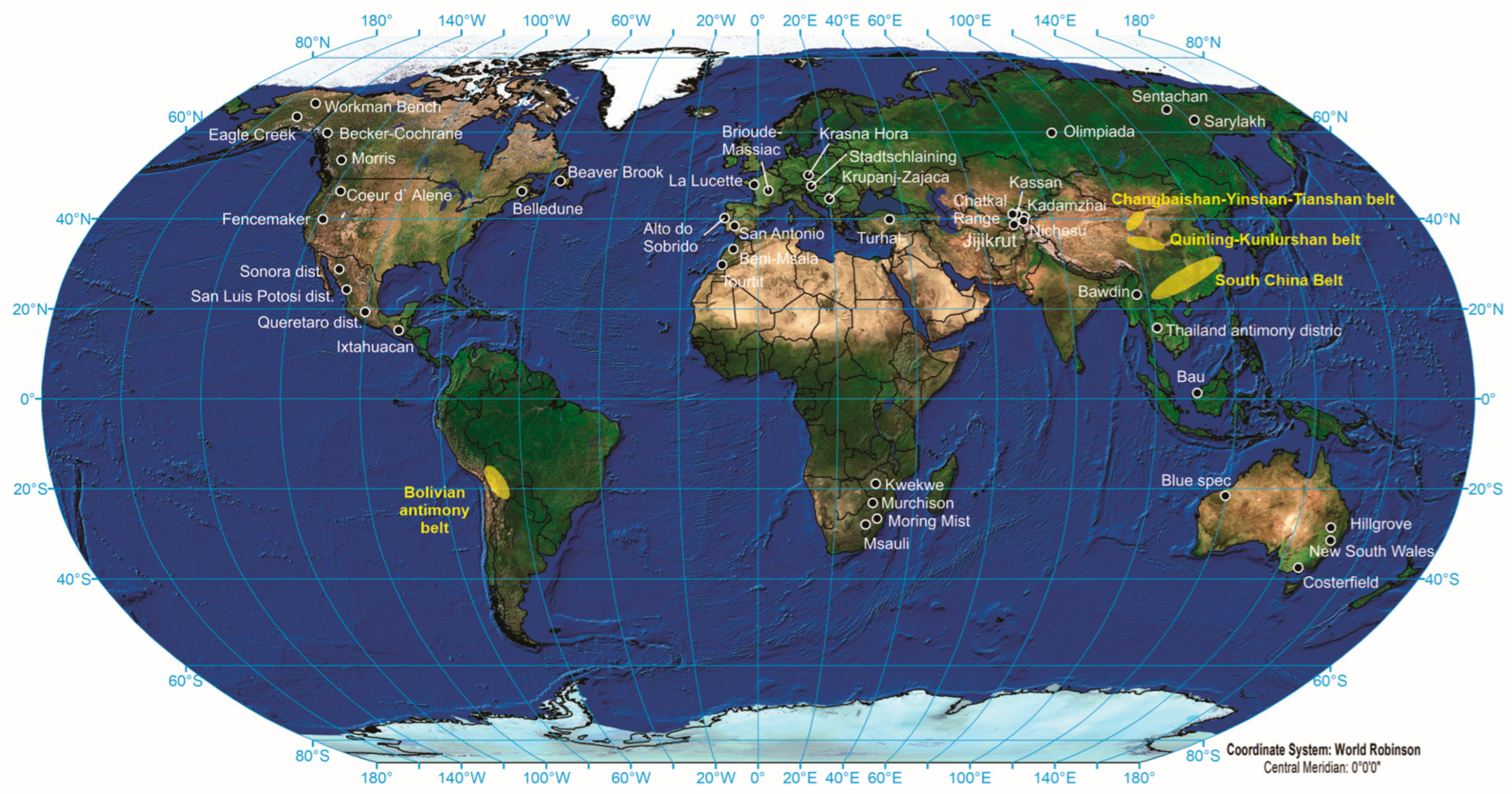
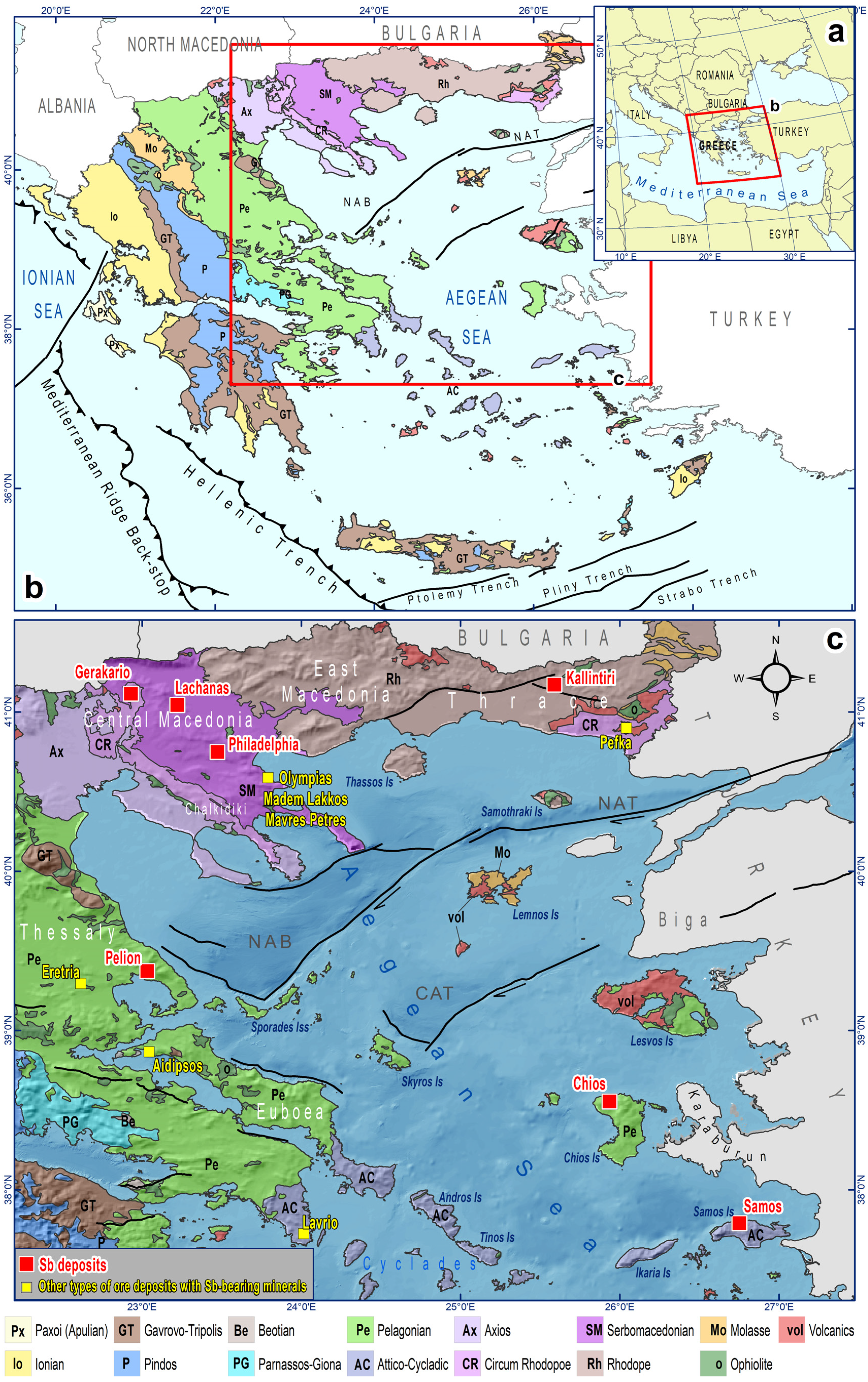


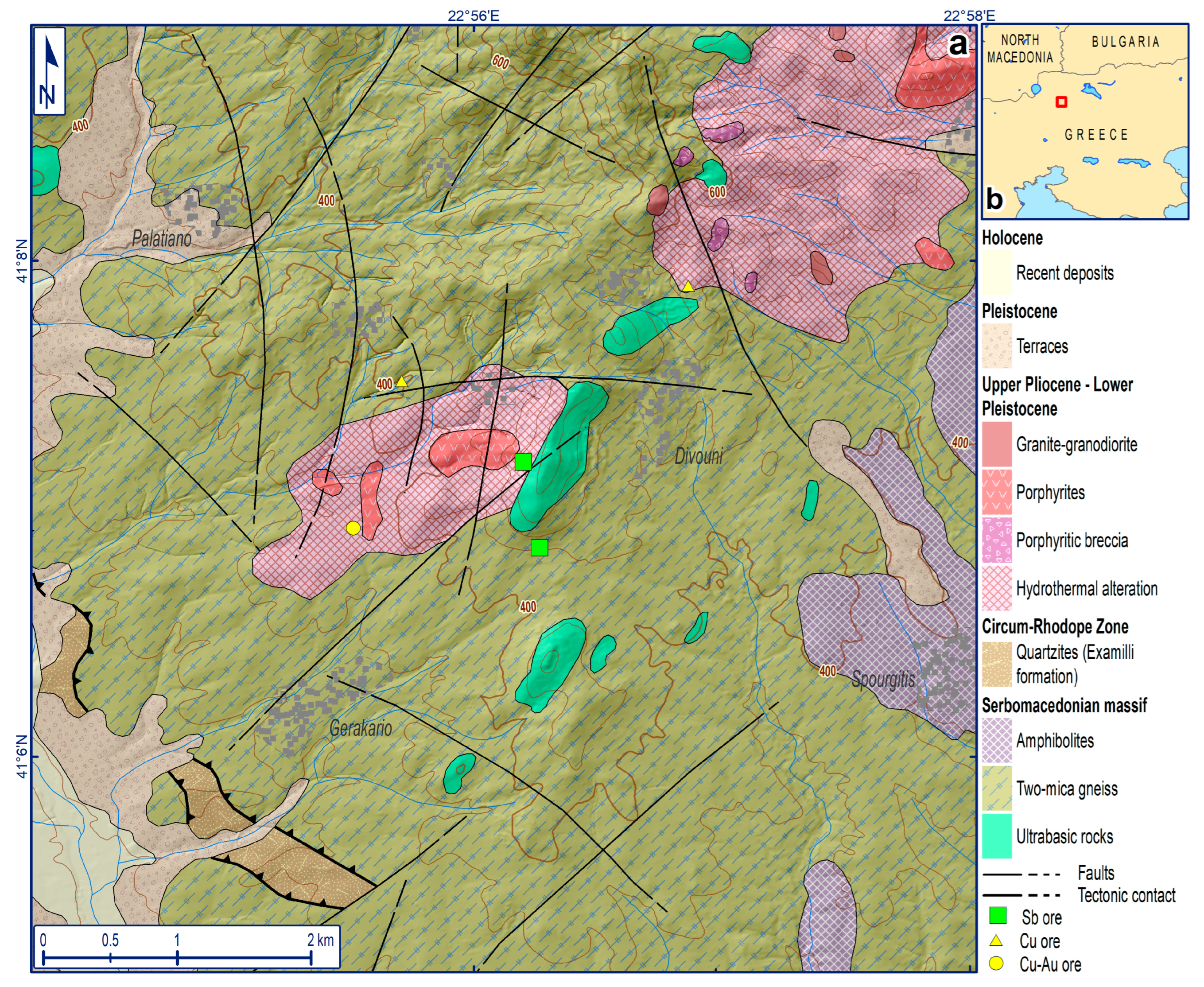
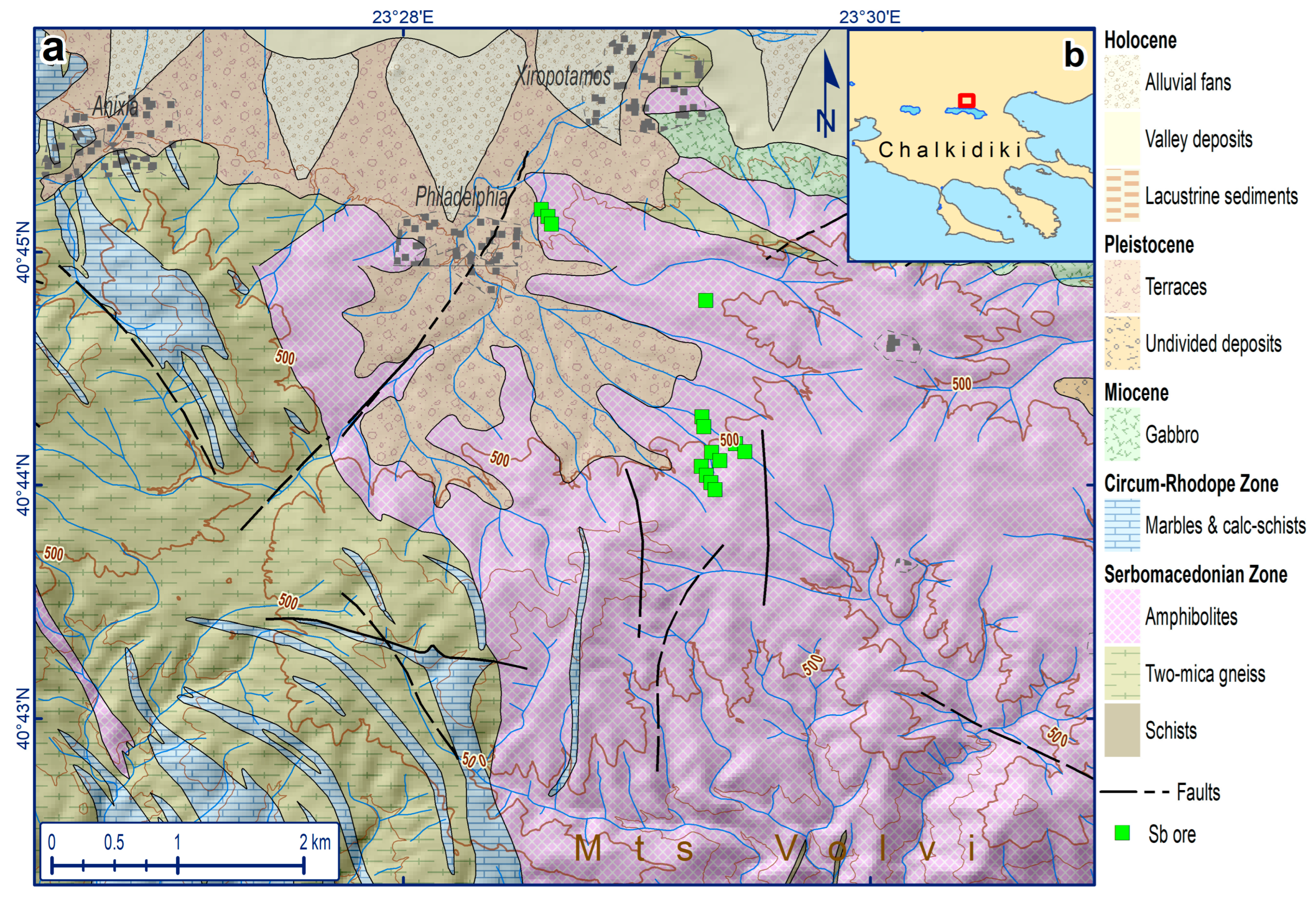
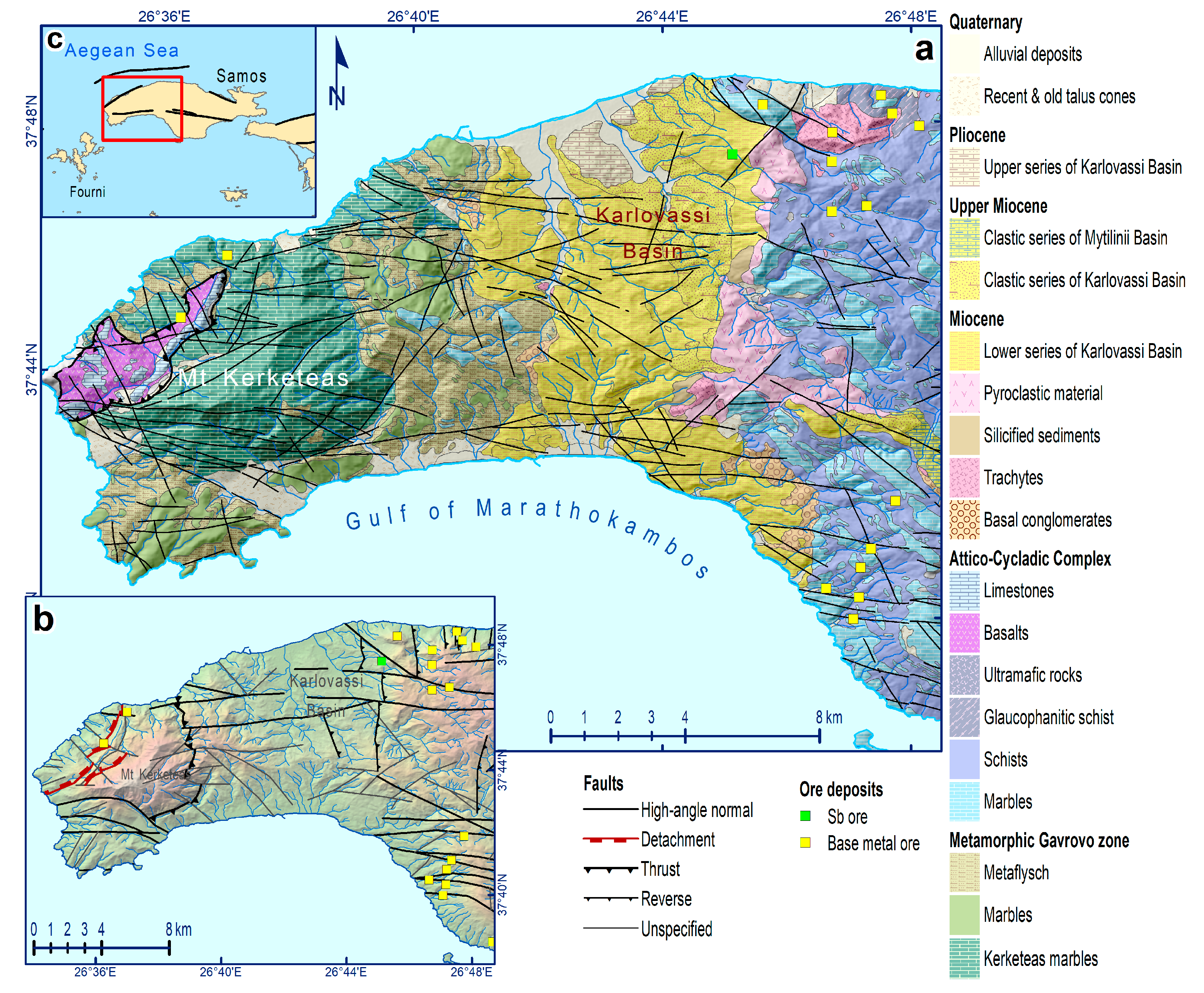
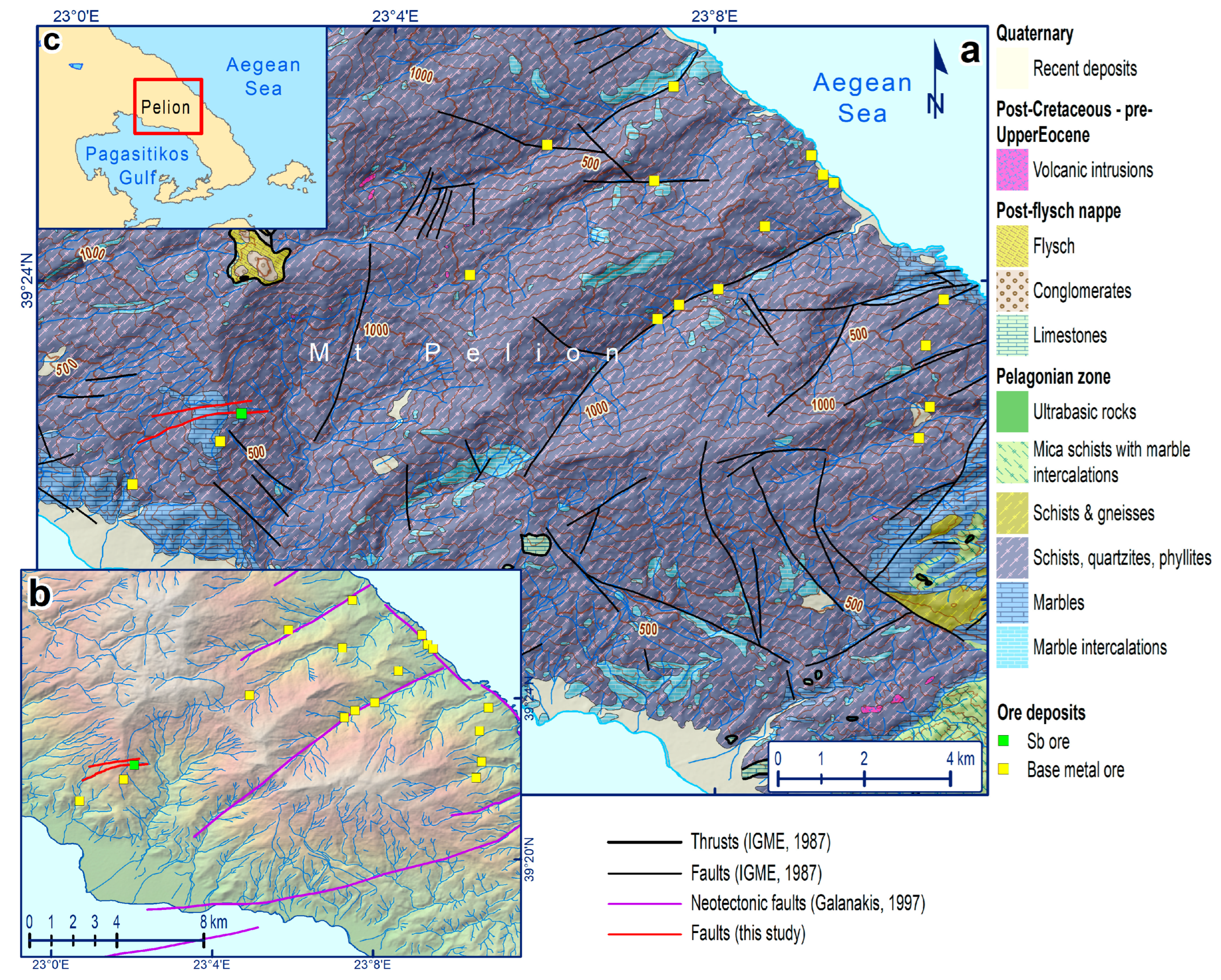
| Location | Possible Related Magmatism | Tectonic Setting during the Mineralization Deposition | Characteristics of the Mineralization | Geotectonic Zone |
|---|---|---|---|---|
| Kallintiri (Rhodope, NE Greece) | Late Eocene to Early Oligocene volcanic rock (andesite) | Ductile to brittle–ductile extensional deformation, low-angle normal detachment faults (D1, Oligocene)Brittle transpressional deformation, WNW-ESE/NW-SE strike-slip faults (D2, Late Oligocene) | Hydrothermal origin, controlled by tectonic processes. The ore mineralization stages are: Stage I: sph *, py *, gn *, fb-ttr *,qtz Stage II: zkn*, bnn*, gn, Pb-Sb sulfosalts [e.g., pgi *, Fül *], Stage III: sbn *, zkn *, Pb-Sb sulfosalts, qtz, cal Stage IV: sbn, sbr, bou, rlg, As(?), qtz, brt, dck | Rhodope massifCircum-Rhodope |
| Lachanas (Central Macedonia, Northern Greece) | Pliocene volcanic rocks (rhyolite, dacite and rhyodacite) | Brittle extensional deformation, ENE-WSW/NE-SW normal faults (Pliocene—Early Pleistocene) | Hydrothermal origin, controlled by tectonic processes. The ore mineralization stages are: Stage I: wf *, py *, apy * Stage II: sbn*, wf, py, As, ccp, Au | Serbomacedonian |
| Philadelphia (Central Macedonia, Northern Greece) | Pliocene volcanic rocks (rhyolite, dacite and rhyodacite) | Brittle extensional deformation, ENE-WSW/NE-SW normal faults (Pliocene—Early Pleistocene) | Hydrothermal origin, controlled by tectonic processes. The ore mineralization stages are: Stage I: sph *, py *, ttr *, apy *, qtz * Stage II: sbn *, ccsb *, ttr, py, apy, znk(?), qtz Stage III: py, znk, kem *, Au *, qtz, clay | Serbomacedonian |
| Gerakario (Central Macedonia, N. Greece) | Pliocene volcanic rocks (rhyolite and dacite) | Brittle extensional deformation, ENE-WSW/NE-SW normal faults (Pliocene–Early Pleistocene) | Hydrothermal origin, controlled by tectonic processes. The ore mineralization stages are: Stage I: apy *, btr *, Sb *, sbn, ccp(?), pyh, lol, qtz Stage II: sbn *, mrc *, py *, apy, Sb, ccp(?), Au, qtz Stage III: sbn *, Au *, py, mrc, qtz | Serbomacedonian |
| Chios Island (Aegean Sea, Eastern Greece) | Middle Miocene volcanic rocks (rhyolite) | Brittle deformation, N-S fault (unspecified age, possibly active until today) | Hydrothermal origin, controlled by tectonic processes. The ore mineralization stages are: Stage I: py *, sph *, ccp *, qtz *, ser Stage II: sbn *, py, ser *, cal *, qtz, Stage III: sbn *, py * | Pelagonian |
| Samos Island (Aegean Sea, Eastern Greece) | Upper Miocene volcanic rocks (mainly trachyte and rhyolite) | Ductile to brittle–ductile extensional deformation, low-angle normal detachment faults (D3, Middle–Late Miocene)Brittle deformation, NNE-SSW/NE-SW (D4, Late Miocene-Pliocene extension-parallel folding) | Hydrothermal origin, controlled by tectonic processes. The ore mineralization stages are: Stage I: sbn *, py *, mrc, qtz, flr, brt, ser, cal Stage II: py *, mrc, qtz, flr *, cal, gp(?) | Attico-Cycladic complex |
| Pelion (SE Thessaly, Central Greece) | Pliocene volcanic rocks (mainly diorite) | Brittle extensional deformation, ENE-WSW/NE-SW normal faults (Pliocene—Early Pleistocene) | Hydrothermal origin, controlled by tectonic processes. The ore mineralization stages are: Stage I: sph *, py *, apy *, qtz *, cal Stage II: sbn *, ccsb *, tnt *, cal *, qtz, dck Stage III: sbn, rlg, dck | Pelagonian |
Disclaimer/Publisher’s Note: The statements, opinions and data contained in all publications are solely those of the individual author(s) and contributor(s) and not of MDPI and/or the editor(s). MDPI and/or the editor(s) disclaim responsibility for any injury to people or property resulting from any ideas, methods, instructions or products referred to in the content. |
© 2024 by the authors. Licensee MDPI, Basel, Switzerland. This article is an open access article distributed under the terms and conditions of the Creative Commons Attribution (CC BY) license (https://creativecommons.org/licenses/by/4.0/).
Share and Cite
Kanellopoulos, C.; Sboras, S.; Voudouris, P.; Soukis, K.; Moritz, R. Antimony’s Significance as a Critical Metal: The Global Perspective and the Greek Deposits. Minerals 2024, 14, 121. https://doi.org/10.3390/min14020121
Kanellopoulos C, Sboras S, Voudouris P, Soukis K, Moritz R. Antimony’s Significance as a Critical Metal: The Global Perspective and the Greek Deposits. Minerals. 2024; 14(2):121. https://doi.org/10.3390/min14020121
Chicago/Turabian StyleKanellopoulos, Christos, Sotiris Sboras, Panagiotis Voudouris, Konstantinos Soukis, and Robert Moritz. 2024. "Antimony’s Significance as a Critical Metal: The Global Perspective and the Greek Deposits" Minerals 14, no. 2: 121. https://doi.org/10.3390/min14020121
APA StyleKanellopoulos, C., Sboras, S., Voudouris, P., Soukis, K., & Moritz, R. (2024). Antimony’s Significance as a Critical Metal: The Global Perspective and the Greek Deposits. Minerals, 14(2), 121. https://doi.org/10.3390/min14020121












